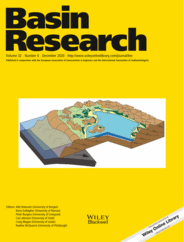
Full text loading...
 , Martina Caratelli2, Massimo Santantonio1
, Martina Caratelli2, Massimo Santantonio1
The role of sea‐bottom topography in the dispersal of shallow water‐derived calciturbidites across a submarine rift, as determined by the local extensional architecture, is under‐investigated, namely with pelagic settings along ancient passive continental margins. A comparison with modern carbonate platform/basin analogues, or with siliciclastic systems, is not always feasible, as ancient carbonate systems were commonly home to anachronistic environments (e.g. the Western Tethyan Mesozoic). Our study focuses on: (a) a reconstruction of the palaeotectonic architecture of the Umbria‐Marche Basin in the Jurassic and on (b) how this architecture produced a submarine topography which governed the dispersal of sediment, shed by the neighbouring Lazio‐Abruzzo Carbonate Platform, for >40 million years. A geological mapping project was performed in the Apennines of Central Italy, a region which in the Jurassic displayed a pattern of intrabasinal highs (pelagic carbonate platforms) and intervening basins which was exceedingly complex due to the high density, and oddly variable trends, of faults rooted in a shallow detachment layer corresponding to thick Triassic salt. A map pairing the occurrences of these resedimented beds with an updated palaeogeography becomes the natural descriptor of the itineraries followed by sediment gravity flows. This qualitative method represents a companion, or even alternative, approach to the one strictly based on physical stratigraphy, and it greatly improves our knowledge of regional geology and rift‐basin analysis. Our case history potentially represents the analogue of hydrocarbon fields both inland and in the offshore. Geological mapping shows that the marginal palaeoescarpments of pelagic carbonate platforms formed obstacles to the gravity flows as sediment load was discharged at their toes. While turbidity flows were locally vigorous enough to climb the escarpments, leaving overbank deposits on the pelagic carbonate platform‐tops, a ‘shelter’ effect is evidenced by the resediment‐free nature of those basins lying downflow, which were shielded by the highs.
,3D (A, B) and 2D (A’, B’) block diagrams illustrating: A‐A’) a hypothetic extensional structure, with stripped‐off post‐Calcare Massiccio sediments, and B‐B’) the possible pathways (dark arrows) of allochthonous shallow‐water material in a pelagic carbonate platform/marginal step/basin depositional system. Not to scale.

Article metrics loading...

Full text loading...
References


Data & Media loading...

